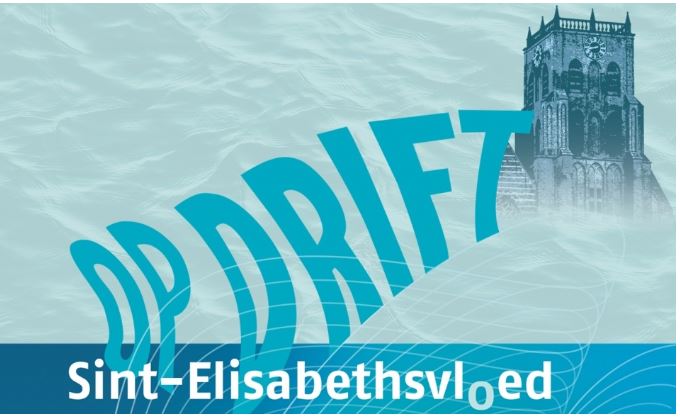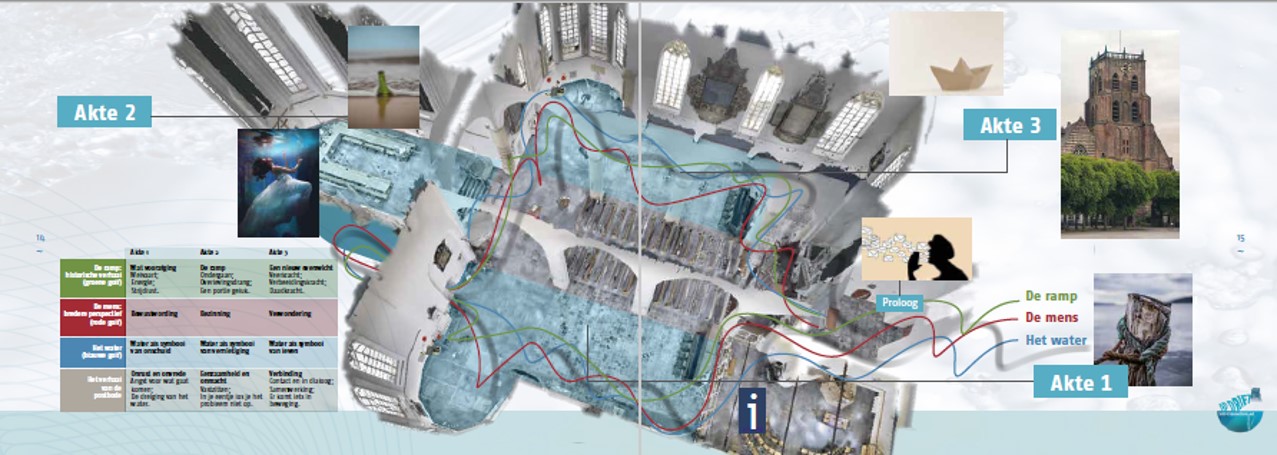The Geertruidschurch sets the stage for a unique visitor experience, an artistic window into the past, present and future. Relive history, reflect on how humankind interacts with the earth, and marvel at the timeless power of water.

PAST-PRESENT AND FUTURE
In 1421 the Netherlands was struck by the Saint Elizabeth flood. This led to the creation of the Biesbosch. The largest freshwater tidal area in Europe. ‘Op Drift’ tells the story of the flood: what preceded it, the disaster and the new equilibrium that emerged. ‘Op Drift’ shows how this disaster was able to happen, which powers and forces played a role before, during and after the flood. It also shows that these powers and forces are of all times, as well as the cycle of innocence, destruction and new life. The St Elizabeth’s Flood is merely an example and is not the only major flood. Over the centuries, people around the world have faced the threat of water and today sea levels are rising faster than ever. On the other hand, there is an increasing shortage of water worldwide and people are struggling with severe droughts, resulting in devastating forest fires. We’re on the edge of disaster, we are standing at a tipping point. What will happen? What movement are we making? And what does the new equilibrium look like? What role do we play as human beings, what about the care for ourselves, for each other and for the earth?

The Geertruidskerk Preservation Foundation (SBG) was founded in 2017 by a number of concerned citizens, after the religious community, through a merger, chose another church as its main church. The beautiful historic building was only used for worship 12 times a year. The idea was to keep the building open and accessible, it had to become and remain a place of inspiring encounters between people. The idea was to get volunteers and citizens more involved in the building and to make sure it would remain meaningful for society. It was decided to go step by step with small exhibitions on the way to a large and significant exhibition full of national interest in 2021. The historical event St. Elisabeth Flood was the starting point. The big theme gave the administrator and the conservation foundation the opportunity to reach out to many people and build relations with new networks. A different way of giving meaning and thinking about how to place the religious heritage at the heart of society has made many new connections possible. Funds and support were obtained, the foundation received from the Province € 40.000,00 via Kunstloc Impulsgelden to make culture more widely accessible in this region. Also, funds for the training and development of the volunteers were received from the Cultural Participation Fund and a donation of one of the largest equity foundations in the Netherlands VSB fund plus full support of the Municipality of Geertruidenberg. It did put the religious heritage site clearly on the map! A side program of workshops, a specially developed theatre piece and music and performance are part of the program.
The exhibition and side program also reaches out especially to primary school children, the elderly, social minorities, etc. It is a good example of how to deal with derelict religious heritage, which is a very big challenge in the Netherlands because many religious heritage sites are becoming abandoned or less in use. It is also a showcase of the benefits of being part of a network as FRH, through the network FRH UK member Jennie Hawks supported the foundation with the translation of all the texts. A team of artists took care of the creative interpretation, in the crypt you are taken under water via a visual digital projection, you are invited to communicate with the postman who is entrenched in the tower, you are challenged to think about contemporary challenges in the area sustainability and environment. And yet cheerfully leave the church to think further about what you have seen and experienced. A visit to Op Drift will leave no one indifferent.
Visit the website here.
Op Drift can be visited until September 2022.
*The above exhibition is an excellent showcase of point 10 of 10 FRH’s Key Findings on the Importance of Religious Heritage: Religious heritage is a strategic resource for “smart, sustainable and eco-focused economies’ and a catalyst for building ‘inclusive, innovative and reflective societies”. Read the document here.
Photo Credits: Stichting Behoud Geertruidskerk





Follow us: